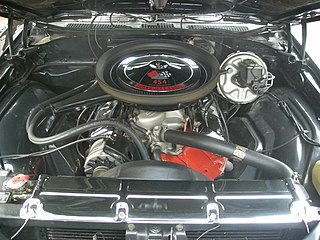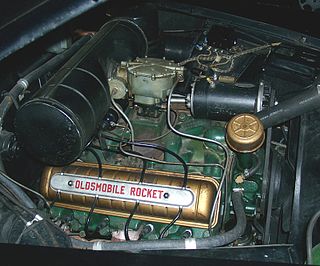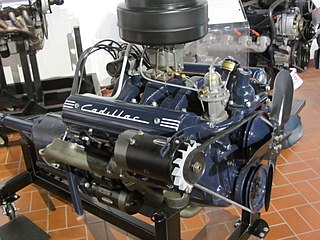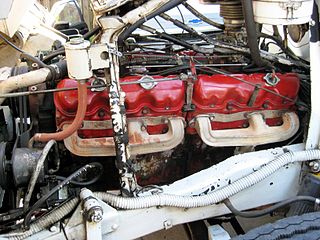
The General Motors LS-based small-block engines are a family of V8 and V6 engines designed and manufactured by American automotive company General Motors. First introduced in 1997, the family is a continuation of the earlier first- and second-generation Chevrolet small-block engine, of which over 100 million have been produced altogether, and is also considered to be one of the most popular V8 engines ever. Spanning three generations, a new, sixth generation is expected to enter production soon. Various small-block V8s were and still are available as crate engines.

The Chevrolet "big-block" engine is a term for a series of large-displacement, naturally-aspirated, 90°, overhead valve, gasoline-powered, V8 engines; that were developed and produced by the Chevrolet Division of General Motors, from the 1950s until present.

The Chevrolet small-block engine is a series of gasoline-powered V8 automobile engines, produced by the Chevrolet division of General Motors between 1954 and 2003, using the same basic engine block. Referred to as a "small-block" for its size relative to the physically much larger Chevrolet big-block engines, the small-block family spanned from 262 cu in (4.3 L) to 400 cu in (6.6 L) in displacement. Engineer Ed Cole is credited with leading the design for this engine. The engine block and cylinder heads were cast at Saginaw Metal Casting Operations in Saginaw, Michigan.

The Iron Duke engine is a 151 cu in (2.5 L) straight-4 piston engine built by the Pontiac Motor Division of General Motors from 1977 until 1993. Originally developed as Pontiac's new economy car engine, it was used in a wide variety of vehicles across GM's lineup in the 1980s as well as supplied to American Motors Corporation (AMC). The engine was engineered for fuel efficiency, smooth operation, and long life, not for performance. Total Duke engine production is estimated to be between 3.8 and 4.2 million units.

The General Motors 60° V6 engine family is a series of 60° V6 engines produced for both longitudinal and transverse applications. All of these engines are 12-valve cam-in-block or overhead valve engines, except for the LQ1 which uses 24 valves driven by dual overhead cams. These engines vary in displacement between 2.8 and 3.4 litres and have a cast-iron block and either cast-iron or aluminum heads. Production of these engines began in 1980 and ended in 2005 in the U.S., with production continued in China until 2010. This engine family was the basis for the GM High Value engine family. These engines have also been referred to as the X engines as they were first used in the X-body cars.
The Chevrolet Stovebolt engine is a straight-six engine made in two versions between 1929 and 1962 by the Chevrolet Division of General Motors. It replaced the company's 171-cubic-inch (2.8 L) inline-four as their sole engine offering from 1929 through 1954, and was the company's base engine starting in 1955 when it added the small block V8 to the lineup. It was completely phased out in North America by 1962, but GM continued to build it in Brazil until 1979. It was replaced by the Chevrolet Turbo-Thrift engine.

The Pontiac V8 engine is a family of overhead valve 90° V8 engines manufactured by the Pontiac Division of General Motors Corporation between 1955 and 1981. The engines feature a cast-iron block and head and two valves per cylinder. Engine block and cylinder heads were cast at Saginaw Metal Casting Operations then assembled at Tonawanda Engine before delivery to Pontiac Assembly for installation.

The Buick V6 is an OHV V6 engine developed by the Buick division of General Motors and first introduced in 1962. The engine was originally 198 cu in (3.2 L) and was marketed as the Fireball engine. GM continued to develop and refine the 3.8 L (230 cu in) V6, eventually and commonly referred to simply as the 3800, through numerous iterations.

The Duramax V8 engine is a family of 6.6-liter diesel V8 engines produced by DMAX, a wholly owned subsidiary of General Motors in Moraine, Ohio. The Duramax block and heads are supplied from reliable vendors of General Motors. This engine was initially installed in 2001 Chevrolet and GMC trucks, and has since become an option in pickups, vans, and medium-duty trucks. In 2006, production at Moraine was reportedly limited to approximately 200,000 engines per year. On May 9, 2007, DMAX announced the production of the 1,000,000th Duramax V8 at its Moraine facility, followed by the 2,000,000th on March 24, 2017.

The Oldsmobile V8, also referred to as the Rocket, is a series of engines that was produced by Oldsmobile from 1949 until 1990. The Rocket, along with the 1949 Cadillac V8, were the first post-war OHV crossflow cylinder head V8 engines produced by General Motors. Like all other GM divisions, Olds continued building its own V8 engine family for decades, adopting the corporate Chevrolet 350 small-block and Cadillac Northstar engine only in the 1990s. All Oldsmobile V8s were assembled at plants in Lansing, Michigan while the engine block and cylinder heads were cast at Saginaw Metal Casting Operations.

The Buick V8 is a family of V8 engines produced by the Buick division of General Motors (GM) between 1953 and 1981. All were naturally aspirated OHV pushrod engines.

The term Cadillac V8 may refer to any of a number of V8 engines produced by the Cadillac Division of General Motors since it pioneered the first such mass-produced engine in 1914.

The Pontiac straight-6 engine is a family of inline-six cylinder automobile engines produced by the Pontiac Division of General Motors Corporation in numerous versions beginning in 1926.
The GMC straight-6 engine was a series of gasoline-powered straight-six engines introduced in the 1939 model year by the GMC Trucks division of General Motors. Prior to the introduction of this new engine design GMC trucks had been powered by straight-six engines designed by the Buick, Pontiac and Oldsmobile divisions of GM.

The GMC V6 is a family of 60-degree V6 engines produced by the GMC division of General Motors from 1959 through 1974. It was developed into both gasoline and diesel versions, and produced in V8 and V12 derivatives. Examples of this engine family were found in pickup trucks, Suburbans, heavier trucks, and motor coaches.

The General Motors–Detroit Diesel V8 engine is a series of diesel V8 engines first introduced by General Motors for their C/K pickup trucks in 1982. Developed in collaboration with GM subsidiary Detroit Diesel, the engine family was produced by GM through 2002, when it was replaced by the new Duramax line. AM General's subsidiary General Engine Products (GEP) still produces a military variant of this engine for the HMMWV.
The GM A platform was a rear wheel drive automobile platform designation used by General Motors from 1925 until 1959, and again from 1964 to 1981. In 1982, GM introduced a new front wheel drive A platform, and existing intermediate rear wheel drive products were redesignated as G-bodies.

The Chevrolet 90° V6 family of V6 engines began in 1978 with the Chevrolet 200 cu in (3.3 L) as the base engine for the all new 1978 Chevrolet Malibu. The original engine family was phased out in early 2014, with its final use as the 4.3 L (262 cu in) V6 engine used in Chevrolet and GMC trucks and vans. Its phaseout marks the end of an era of Chevrolet small-block engine designs dating back to the 1955 model year. A new Generation V 4.3 L (262 cu in) V6 variant entered production in late 2013, based on the LT1 small block V8 and first used in the 2014 Silverado/Sierra 1500 trucks.

The Chevrolet Turbo-Thrift engine is a straight-six produced from 1962 to 2001 by the Chevrolet division of General Motors. The entire series of engines was commonly called Turbo-Thrift, although the name was first used on the 230 cubic inch version that debuted in 1963. The new engine featured seven main bearings in lieu of the four bearing design of its predecessor, the "Stovebolt" engine, and was considerably smaller and approximately 100 lbs lighter.
















